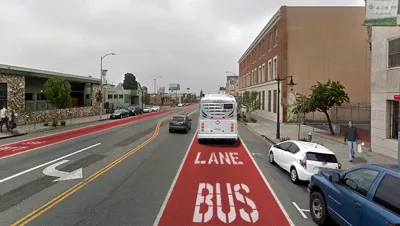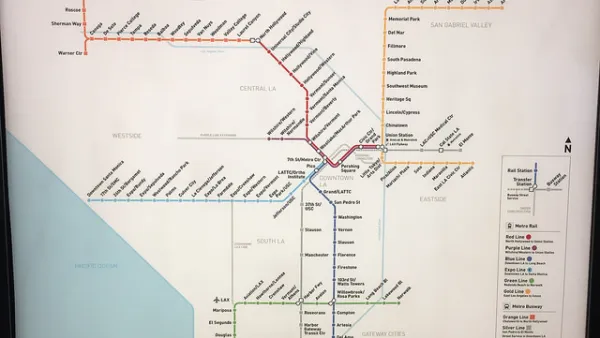Anyone hoping for rail transit down one of Los Angeles' busiest transit corridors will have to wait awhile.

When Los Angeles voters approved Measure M in 2016, they provided some funding for a planned bus rapid transit (BRT) route down 12.4 miles of the very busy Vermont Avenue corridor. That project is scheduled to begin in 2024 and open by 2028, if complete funding construction is acquired before then.
Now, however, the Los Angeles County Metropolitan Transportation Authority (Metro) is making plans to turn that BRT project into a light rail route in the very distant future.
"A report to be given this week to the Metro Board's Planning and Programming sheds light on how an as-of-yet unbuilt bus rapid transit line on Vermont Avenue could be converted into a rail line in the distant year of 2067," reports Steven Sharp.
The report studies rail transit as an option and comes up with three options, explains Sharp:
- Center-running light rail transit - similar to the Blue Line - with below-grade between operations between Wilshire/Vermont Station in Koreatown and Gage Avenue, where trains would proceed to an at-grade alignment within a wide center median to 120th Street;
- An extension of the Red Line starting at the corner of Vermont and 3rd Street, continuing south in a fully below-grade alignment to 120th Street; and
- A standalone heavy rail line starting at Wilshire/Vermont Station and proceeding below-grade to 120th Street.
In current construction costs, these projects would require between $4.4 billion on the cheap end and $8.4 billion on the expensive end. In 2067 costs, that would be $21.1 billion and $34.7 billion.
The largest impediment to any new transit on Vermont Avenue is funding, according to Sharp. Even the BRT project only has $25 million in funding from the Measure M total.
For insight into the importance of Vermont Avenue in the Los Angeles regional transit system, see an opinion written by Alon Levy in early 2018.
FULL STORY: Study Explores How Metro Could Convert the Proposed Vermont BRT Line to Rail

National Parks Layoffs Will Cause Communities to Lose Billions
Thousands of essential park workers were laid off this week, just before the busy spring break season.

Retro-silient?: America’s First “Eco-burb,” The Woodlands Turns 50
A master-planned community north of Houston offers lessons on green infrastructure and resilient design, but falls short of its founder’s lofty affordability and walkability goals.

Delivering for America Plan Will Downgrade Mail Service in at Least 49.5 Percent of Zip Codes
Republican and Democrat lawmakers criticize the plan for its disproportionate negative impact on rural communities.

Test News Post 1
This is a summary

Test News Headline 46
Test for the image on the front page.

Balancing Bombs and Butterflies: How the National Guard Protects a Rare Species
The National Guard at Fort Indiantown Gap uses GIS technology and land management strategies to balance military training with conservation efforts, ensuring the survival of the rare eastern regal fritillary butterfly.
Urban Design for Planners 1: Software Tools
This six-course series explores essential urban design concepts using open source software and equips planners with the tools they need to participate fully in the urban design process.
Planning for Universal Design
Learn the tools for implementing Universal Design in planning regulations.
EMC Planning Group, Inc.
Planetizen
Planetizen
Mpact (formerly Rail~Volution)
Great Falls Development Authority, Inc.
HUDs Office of Policy Development and Research
NYU Wagner Graduate School of Public Service





























